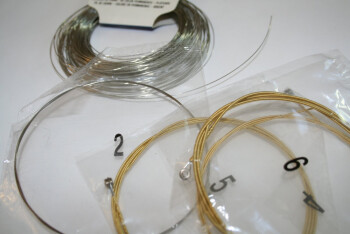Fans of alternate tunings (especially metalheads) will often find themselves with overcooked noodles instead of strings, compromising their sound. Here are a couple of recipes to make sure your strings are always "al dente."
The spaghetti incident
Strings that are too loose entail several problems:
The pitch is compromised, depending on the force of the attack of the right hand, especially with open strings. If you take your time to practice like a madman and be impeccable in terms of rhythm, it would be stupid to let all your efforts go down the drain due to pitch problems.
If the strings offer little resistance to the pick, the playing is conditioned, since the guitar player will be forced to barely touch the strings to play them. The sound loses a lot of dynamics and presence when you do not attack the strings with enough strength.
Besides, the neck may not appreciate the lack of tension. Over time, it may bend if not adequately adjusted.
Can my guitar take all that?
Before you rush into a store to get a 13–68 string set, first ask yourself the next question: Do the corresponding guitar parts (bridge, nut, and tuners) have the right dimensions for the new strings? Because it’s not unusual for the holes to be too small above a certain gauge, which will force you to lower a bit your expectations or change certain parts of your guitar ─ if it’s worth the effort. In this respect, you should know that you are gonna need some patience and special tools (like these by Ibanez, for example) to correctly increase the size of the nut.
The influence of the scale length
The length between the nut and the bridge is also part of the equation involving the load on the neck, the frequency of the desired note and the string gauge. Thus, a short (Gibson-like) scale requires a thicker gauge than a long (Fender-like) scale to achieve the same tension.
Choosing the right gauge
You have two options to equip your guitar with custom strings:
Create your own string set by choosing the gauge of each string individually. A pertinent approach, which will nevertheless require you to study the matter seriously. To that end, you can take a look at this gauge calculator, for example, or find others online. Do note, however, that not all manufacturers provide enough info about their strings to be able to do the calculations (although the values can usually be extrapolated between brands).
Choose a “commercial” set of strings. To make your life easier in the jungle of string gauges, I have decided to provide you a table where I summarize everything I have learned so far. It’s not the Rosetta Stone of the open-drop geek, but it’s a good starting point in your quest for your own personal Holy Grail. To download it, you just have to click here.
Finally, if the neck and the vibrato can stay in place when the tension of the strings is similar to that of a standard gauge tuned to E, the intonation will often require a substantial adjustment to be able to play in tune all along the neck.


